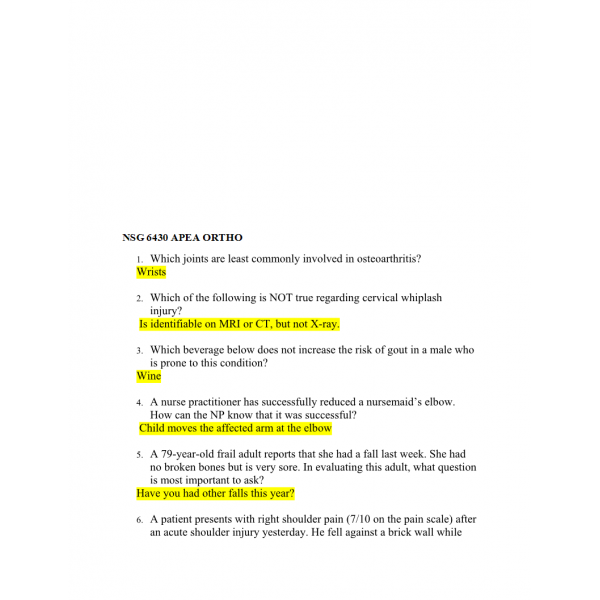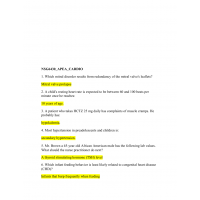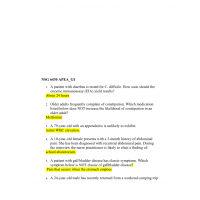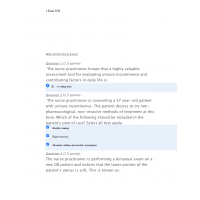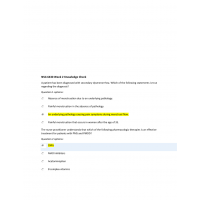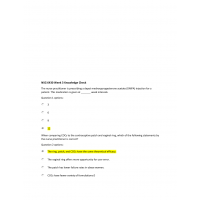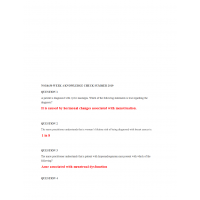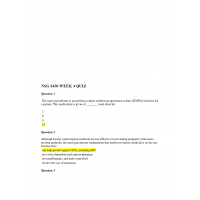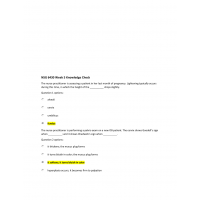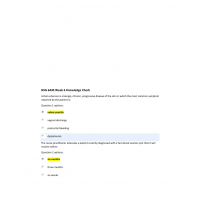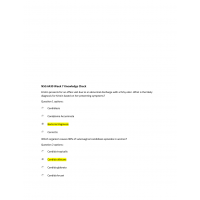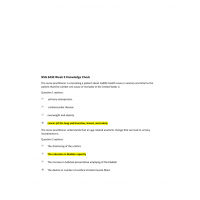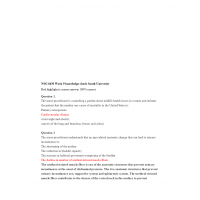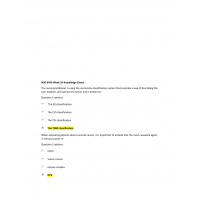NSG 6430 APEA Ortho
APEA_ORTHO_NSG6430
- Which joints are least commonly involved in osteoarthritis?
- Which of the following is NOT true regarding cervical whiplash injury?
- Which beverage below does not increase the risk of gout in a male who is prone to this condition?
- A nurse practitioner has successfully reduced a nursemaid’s elbow. How can the NP know that it was successful?
- A 79-year-old frail adult reports that she had a fall last week. She had no broken bones but is very sore. In evaluating this adult, what question is most important to ask?
- A patient presents with right shoulder pain (7/10 on the pain scale) after an acute shoulder injury yesterday. He fell against a brick wall while working at his home. He reports pain that radiates into his upper arm. How should this be managed?
- Management of a sprained ankle includes:
- A 49-year-old patient has osteoarthritis in the lumbar spine and hip. His hip X-ray demonstrates bone on bone. What can be done to resolve his complaints of pain in his hip?
- A young athlete is found to have a depression of the longitudinal arch of both feet. He complains of bilateral heel pain. The rest of his foot is normal and he has continued with his activities. What could be recommended for his heel pain?
- A patient cut himself on a fence post while working outside. He has not had a tetanus shot in more than 10 years. How long can he wait before getting the immunization and still prevent tetanus?
- An 80-year-old patient is very active but presents today with posterior hip pain for the past week. Which of the following is least likely part of the differential diagnosis?
- The Ottawa ankle rules help the examiner determine when:
- A patient complains of pain in his right heel. Initially, it began with his first steps out of bed in the morning, but over the past few weeks he has heel pain throughout the day. What factor has contributed most to his worsening heel pain?
- Clubfoot:
- A 45-year-old male who is in good health presents with complaints of pain in his left heel. He states that the first few steps out of bed in the morning are extremely painful. He has no history of trauma. What is the likely etiology of his pain?
- Which of the following is true about metatarsus adductus?
- A 75-year-old patient has osteoarthritis and pain. Which of the following medications increases the risk of a GI-related ulceration?
- Which diagnosis is the least likely cause of extrinsic shoulder pain?
- A 60-year-old has been on NSAIDs and hydrocodone for the past 48 hours for shoulder pain. He has complaints of blood on toilet tissue when wiping after a bowel movement this morning. What should be suspected?
- A characteristic of rheumatoid arthritis not typical in osteoarthritis is:
- A patient reports that her knee “locks” sometimes and feels like it will “give out.” She denies injury. She has no complaint about her other knee. What is her likely problem?
- An older adult had a total knee replacement (TKR) 10 months ago. He is doing well. He states that he is having a dental procedure performed in 1 week. What information should he be given regarding the knee replacement?
- Which patient below should be screened for osteoporosis?
- The drop arm test is used to assess patients with suspected:
- A 14-year-old male client reports dull anterior knee pain, exacerbated by kneeling. What is the likely etiology?
- A 75-year-old has pain from osteoarthritis in her right knee. What intervention is considered first line to treat her pain?
- Bone mineral density screening in women older than 65 years is an example of:
- A 12-year-old male with hip pain presents to the NP clinic. Hip pain has occurred with activity for the past 4-6 weeks, but his pain is worse and now involves the knee. There is no history of trauma. How should the workup be initiated?
- An older adult with a complaint of shoulder pain has a positive “drop arm” test. What is his likely diagnosis?
- A 16-year-old complains that his knees hurt. His mother states that he has complained of knee pain for the past 2 weeks. He has a prominent tibial tubercle. What should be part of the differential diagnosis?
- A 55-year-old male patient describes severe pain at the base of his left first toe. He is limping and says he can’t remember hurting his toe. Which symptom below suggests something other than gout?
- Which statement below best characterizes scoliosis in an adolescent?
- A 16-year-old male plays trumpet in the school marching band. He has had marching practice every day for the last week. Today he complains of pain in his left midfoot. The foot is neither swollen nor red. What is the most likely diagnosis in the differential?
- A man fell off a 3-foot stepladder while working at home. He presents to your office with complaints of foot pain. He has point tenderness over the medial malleolus and swelling, but he is able to ambulate. How should this be managed?
- A male patient who injured his back lifting a heavy object reports that he has low back pain. He is diagnosed with a lumbar strain. He is afraid to continue activities of daily living, especially walking, because he has pain with these activities. What statement below is true?
- A long distance runner is diagnosed with a tibial stress fracture. Which statement is true about the injury?
- A patient has suspected plantar fasciitis. The plantar fascia is best examined:
- An adolescent complains of knee pain. He is diagnosed with Osgood- Schlatter disease. What assessment finding is typical?
- A positive Tinel’s test can be used to assess carpal tunnel syndrome. What other test can be used to assess for this?
- A 50-year-old patient reports acute pain in his lower back that started 2 weeks ago after working in his yard. The pain radiates into his right leg intermittently. He has been managing his pain with ibuprofen. There are no red flags in his history or on exam. When should consideration be given to imaging studies?
- A 70-year-old patient has had intermittent back pain secondary to a bulging disk for more than 3 years. In the last year, it is constant (pain scale is 2-3/10) and at times is sharp. She is not a surgical candidate. What class of medication would be a good choice for improvement of chronic pain in this patient?
- A patient is at increased risk of osteopenia if she uses which form of birth control?
- A 65-year-old male is diagnosed with an initial episode of gout. It is likely that he:
- An adolescent athlete has sprained his ankle. What instruction should be given to him regarding activity?
- If plantar fasciitis is suspected in a patient, how is this diagnosed?
- An 8-year-old has a painful limp. He reports that his knee hurts medially. On exam he has pain with internal rotation of the hip. How should the NP manage this situation?
- What should the nurse practitioner assess in an 80-year-old patient who reports a fall but does not have serious physical injury?
- A 60-year-old adult with an antalgic gait and complaints of hip pain is examined. He has trochanteric tenderness. What is the most common cause of this?
- A 2-year-old was brought into the clinic by her mother who reports that she pulled her arms upward to pick her up and now the child won’t use her right arm. A nursemaid’s elbow is suspected. Which statement below is correct?
- Which findings are most commonly associated with rheumatoid arthritis?
- A patient who frequently has episodes of gout should avoid which groups of food?
- A 60-year-old female presents with history of low back pain of recent origin. Her gait is antalgic and she reports loss of bladder function since the onset ofback pain this morning. What should be done?
- What medication is recommended by the American College of Rheumatology as a first line agent for a patient who has been unsuccessful with nonpharmacologic interventions for osteoarthritis pain?
- What is the value of vitamin D supplementation in the diet of older adults?
- A 65-year-old female complains of left medial knee pain. She has been told that she has arthritis in this knee. Where would the pain be located?
- A 72-year-old patient complains of knee pain when she climbs stairs or walks long distances. Crepitus is palpable in the affected knee. What is the likely cause?
- A patient with sciatica is most likely to describe relief of symptoms with:
- A high purine diet can contribute to gouty arthritis. Which food listed below contributes most to a high purine diet?
- What is the most prevalent skeletal problem in the United States?
- A 6-year-old complains that his legs hurt. His mother states that he has complained for the past 2 weeks, and she thought it was from “playing outside too much”. When asked to identify the painful areas, the child points to the midshaft of the femurs. He grimaces slightly when asked to walk. What should be part of the differential diagnosis?
- A positive Trendelenburg’s test could be used to identify a child with:
- A 75-year-old female who is otherwise healthy has mild osteoarthritis in her right knee. She complains of pain not relieved by acetaminophen 2000 mg daily. What should be done?
- Ankle inversion is a common complaint from a patient with a:
- A 66-year-old African American female has multiple risk factors for osteoporosis. Which choice listed below is NOT a risk factor for osteoporosis?
- Which factor listed below is NOT considered a risk factor for development of osteoporosis?
- When should functional rehabilitation occur once a patient has had an ankle or knee sprain?
- Which of the following tests, if positive, is part of the criteria for systemic lupus erythematosus (SLE)?
- A male patient takes HCTZ daily for hypertension. He developed severe pain in his great toe yesterday. He was diagnosed with gout today and started on a medication. Which medication listed below would be contraindicated at this time?
- What does a positive anterior drawer test demonstrate in a patient who has an injured knee?
- A 60-year-old patient who is otherwise healthy presents with acute onset of right knee pain. She denies injury but reports that she walked up a lot of steps yesterday. She is diagnosed with prepatellar bursitis. What is a common finding?
- A 6-year-old complains that his legs hurt. His mother states that he has complained for the past 2 weeks, and she thought it was from “playing outside too much”. When asked to identify the painful areas, the child points to the midshaft of the femurs. He grimaces slightly when asked to walk. What is the most important initial intervention?
- A 75-year-old female who knits daily has a positive Finkelstein test. What is her likely diagnosis?
- An adolescent athlete has injured his ankle playing basketball. He has right ankle pain, ecchymosis, and significant edema, and he is unable to bear weight at the time of the clinical exam. Which diagnosis is least likely?
- When is Osgood-Schlatter disease most likely to produce symptoms?
- A 40-year-old complains of back pain after heavy lifting. This began 2 weeks ago. He has had little improvement in his pain. Which statement is true regarding plain X-rays in this patient?
- A 70-year-old African American male complains of pain in his back and trunk. Cardiovascular disease is ruled out. Laboratory studies were obtained. A likely diagnosis is:
- A 62-year-old female presents with atraumatic right knee pain. On exam, she has a mildly swollen right knee that is not warm or tender to touch. She has a negative McMurray test. An x-ray was obtained. How should the nurse practitioner interpret the results of this X-ray?
- A college age basketball player landed awkwardly on his foot and ankle after jumping during a game yesterday. He states that he sprained his ankle. He complains of ankle pain and foot pain but is able to limp into the exam room. How should he be managed?
- Which symptom can be used to rule out a fracture?
- Which statement below is true regarding NSAIDs for low back pain?
- Women are commonly screened for osteoporosis at age 65 years. How should screening for osteoporosis be managed in a male this age?
- A 72-year-old patient complains of knee pain when she climbs stairs or walks long distances. Crepitus is palpable in the affected knee. What is the likely cause?
- The average age of pubertal growth spurt in North American boys is:
| Institution & Term/Date | |
| Term/Date | South University |
-
$35.00

